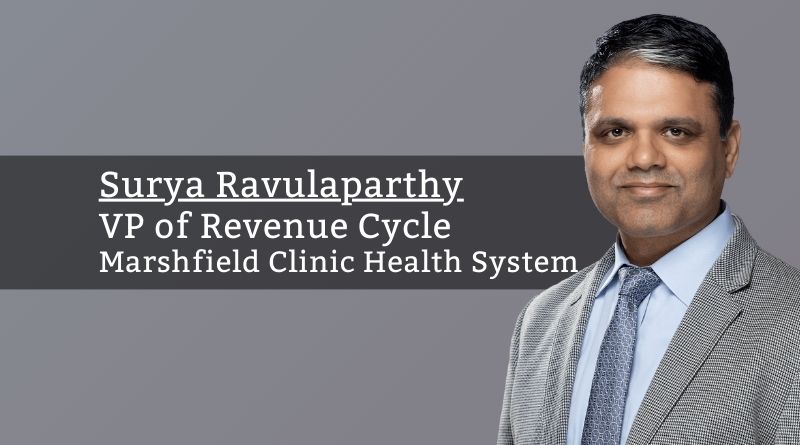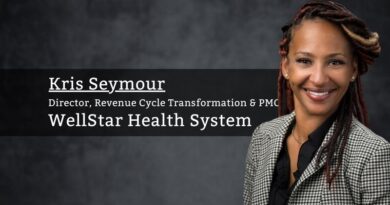Marshfield Clinic Health System’s Technology-Driven Revenue Cycle Optimization
By Surya Ravulaparthy, VP of Revenue Cycle, Marshfield Clinic Health System
Health care providers continue to experience financial pressures due to various internal and external factors, like declining reimbursement rates, rising inflation, declining workforce availability and complex regulatory requirements. Marshfield Clinic Health System has not been immune to these factors and has been focused on a Financial Improvement Plan throughout 2023. As part of this Financial Improvement Plan, the health system embarked on a comprehensive revenue cycle optimization effort that looked at traditional and innovative solutions to create meaningful financial impact.
Areas of Focus
The health system has undergone a multi-year Electronic Medical Record (EMR) installation over the last couple years. This resulted in a 2023 focus for revenue cycle optimization on (a) a one-time cash acceleration by reducing the Discharge Not Final Billed (DNFB) and billed Accounts Receivable (A/R) backlogs; and (b) a sustainable net revenue improvement through comprehensive revenue integrity and reduction of administrative write-offs.
To achieve these objectives, the revenue cycle optimization efforts were divided across four pillars of work: DNFB Reduction, A/R and Denial Management, Revenue Assurance and Pricing and Denial Prevention. Each pillar identified and implemented initiatives across people, processes and technology.
The remainder of this article will focus on the technology initiatives, especially ones considered innovative solutions that go beyond the traditional EMR optimization.
Solutions
Limited availability of revenue cycle resources and rising labor costs have been key driving factors to look for innovative solutions to create meaningful impact across the revenue cycle. To create this impact, organizations need to rely on various avenues like data science and machine learning (ML), intelligent automation and data analytics, versus relying on just one solution like Robotic Process Automation (RPA).
Data Science and ML
As most readers know, revenue cycle within any health system is driven by data. With over 73,000 diagnosis codes, 10,000 procedure codes, 80 locations, 400 health plans and other key variables, there are billions of reasons why an individual encounter becomes a revenue cycle issue. At the health system, we rely on the use of practical data science and ML to organize work quickly for our revenue cycle teams that has exceeded the capabilities of rules-based systems designed in the past.
For the DNFB reduction initiative, we targeted high-value encounters buried inside of complicated system logic or worklists, identified programmatic fixes that may be available and worked with Information Services and other teams to resolve and optimized our resources and team structures based on the patterns identified through data science.
For the billed A/R and denials management initiative, we used data science and ML to drive enhanced collections performance across the entire account population by connecting similar work across revenue cycle functions. We have embarked on a comprehensive A/R prioritization effort that goes well beyond the high-dollar and aged worklists that have been traditionally used to drive work in the back end of the revenue cycle.
At Marshfield Clinic Health System, we rely on the use of practical data science and ML to organize work quickly for our revenue cycle teams that has exceeded the capabilities of rules-based systems designed in the past.
Automation
Intelligent automation is being used across several revenue cycle functions. Forexample, we are implementing automated administrative intake in partnership with a leading intelligent automation company. We have automated appointment reminder outreach, collection of demographic information, consent forms, insurance forms and insurance cards. Another area being evaluated for RPA is the resolution of credit balances. Health System teams are engaged in developing Process Definition Documents (PDDs) that will be used to design automation for these processes.
Data Analytics
The health system relies on robust data analytics for decision-making in partnership with our internal Analytics Center of Excellence (ACE). Working with ACE, we developed a comprehensive set of dashboards to monitor revenue and usage reporting, pre-claim edits, claims, billed A/R and denial and write-offs. These dashboards allow our leadership teams to track the health of our revenue cycle metrics, use underlying data to root cause issues and collaborate across revenue cycle, operational and clinical areas.
AI Governance
As the health system continues to expand the use of AI across the system, in the summer of 2023, we established an AI governance program that ensures responsible and ethical adoption of AI technologies within the health system enterprise. The goal of this program is to mitigate risks and harms that can be caused by AI systems. The governance council comprises a diverse group of individuals charged with the responsibility of reviewing all requests to develop or acquire AI technology. It also provides oversight of the ongoing responsible use of AI technology.
Workforce Impact
As we implement AI and automation solutions, the need to accommodate the impact of these solutions on our workforce is ever-increasing. With the adoption of these solutions, there is a constant need to address our workforce levels, reallocate and re-educate our staff constantly and allocate resources to implement these solutions. At the health system, we are exploring avenues to address these needs, like flexing our vendor resources based on automation levels and maintaining a cross-functional pool of resources for problem-solving and technology implementation.
Path Forward
As we continue our revenue cycle optimization journey in 2024, we expect to double down on our use of intelligent automation and responsible AI throughout the revenue cycle. While the journey continues along the various initiatives listed in this article, we will continue to look at other areas to automate to improve our patient experience.



